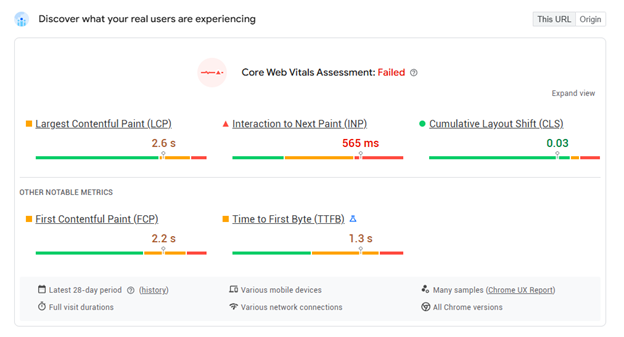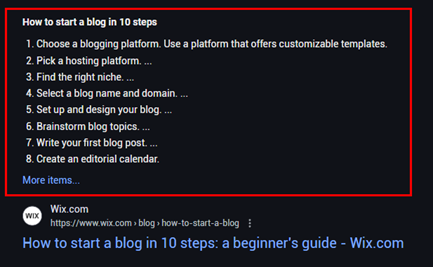If your pages aren’t ranking, they’re not serving your goals. Unless your goals are wasting a lot of time writing blogs that nobody else will read. If that is your goal, well, you do you, I’m not going to judge. But many of us are writing blogs with hopes of gaining reach and authority.
On-page SEO is where you take control by fine-tuning the content, structure, and signals that search engines use to decide who shows up first.
We’re not talking about tricks or hacks. Strong on-page SEO is about making smart, measurable improvements that drive real traffic and revenue.
Fortunately, we can distill down our optimizations to a series of actionable and proven on-page SEO techniques that move the needle.
What is on-page SEO?
On-page SEO refers to the practice of optimizing web pages to improve their rankings and attract relevant organic traffic.
It involves making strategic enhancements directly to your content, HTML code, and overall site structure to help search engines see that your content is valuable, relevant, and user-friendly.
When you tackle on-page search engine optimization, you’re addressing critical elements like your title tags, meta descriptions, headings, content quality, internal links, and image optimization.
Getting these foundational aspects right can significantly boost SEO performance, increase click-through rates, and drive more conversions.
While on-page SEO appeases search engines, the result of well-optimized pages is also a better user experience. It makes your content more readable, engaging, and valuable for readers, which obviously helps you achieve your business goals and leads to higher ROI.
In contrast, off-page SEO refers to actions taken outside of your website to influence your search engine ranking. This includes strategies like link building, building brand mentions, and increasing social media signals.
Unlike on-page SEO, which focuses on optimizing elements you control, off page SEO relies on how others interact with and reference your site across the web. Both are essential, but on-page SEO is the foundation you build.
Why are on-page SEO techniques important?
On-page SEO techniques are crucial because they directly impact your site's ability to attract high-quality organic traffic and boost conversions.
If you do it right, strong on-page SEO helps search engines (and we’re mostly talking about Google Search) understand the value of your content. And if search engines like your content, they’ll put it in front of your ideal customers.
Ultimately, investing in on-page SEO has a tendency to stretch your marketing dollars because you get more valuable out of each piece of content you produce. Rather than constantly spending on paid channels to get visibility, you can build free, sustainable, long-term traffic.
16 on-page SEO techniques to boost performance
Small on-page improvements compound over the scope of your site and over time. With a few changes, you can turn a dormant piece of content into a top performer.
1. Structure content around strategic keyword clusters
Everyone knows that each page on your site should be built around a specific, unique keyword, but that shouldn’t be the end of its story.
Instead, structure your content around keyword clusters. This technique is vital because search engines prefer comprehensive, authoritative content that fully covers topics. It also tends to make your writing more natural and less optimized for robots.
To build effective keyword clusters, identify your primary keyword with the help of keyword research tools like Siteimprove’s Unified Search Insights. Alternatively, you can use their Cluster Analysis Document to determine how to build out the cluster. Use the Cluster>Analysis>Brief workflow to generate appropriate briefs for both creating new content and optimizing existing pages that support the cluster.
2. Include keywords in the right places
Once you have your keywords, it’s important to use them in places that search engines care about. This improves your chances of ranking for relevant queries.
Focus on including your primary keyword in high value places.
- Page title (title tag)
- H1 heading
- First paragraph of your content
- URL (if possible and natural)
- Subheadings (H2s and H3s)
- Image file names
- ALT text
- Meta description
- Anchor text for internal links
- Closing paragraph
Use secondary keywords naturally throughout the content, but keep your writing clear and readable. Avoid keyword stuffing or forcing terms where they don’t belong. Your goal is to signal relevance while still keeping the content helpful and engaging for real people.
3. Optimize title tags and meta descriptions for click-throughs
Your title tag and meta description are often the first thing people see in search results, so they need to work hard.

A strong title grabs attention and quickly tells users what your page is about. Keep your titles under 60 characters and put your primary keyword up front.
A clear, benefit-driven meta description gives them a reason to click. Aim for around 155 characters. Focus on what makes the page valuable, like a unique insight, clear benefit, or next step. You can even add a CTA if you’re feeling spicy.
Keywords in your meta description won’t help your page rank, but users are more likely to click on results with keywords in the description.
Use Google Search Console to spot pages with low click-through rates, then test new wording to see what resonates. Small changes here can lead to big wins.
4. Organize page content with headings
A clear heading structure makes it easier for people (and robots) to scan your page and find what they need. And when your headings are well-organized, search engines can better index your content. This improves your chances of ranking and even showing up in featured snippets.
Start with an H1 that includes your main keyword, then break the page into sections using H2s and H3s. Make sure each heading gives a quick, clear preview of what the section is about. Lots of websites use H1 and H2 settings as design choices, so there are often a lot of headings on pages that aren’t helping your site at all.
When possible, work in secondary keywords naturally into your headings. This improves readability and signals relevance to search engines.
5. Match content to user intent
To drive real results, your content needs to supply the kind of content that people are seeking when they search for a specific keyword. We call this “intent.”
Before creating a piece of content, ask yourself, “What is the searcher’s intent?” Are they trying to learn something? Compare options? Make a purchase? Your page needs to deliver the right kind of value or it won’t perform.
Start by checking the search results for your target keywords. See what types of pages show up first. If all of the results are how-to guides, your product page probably won’t get a lot of clicks.
Match the format, tone, and depth to what users expect. Be clear about what’s inside your content so the searcher knows that they’re in the right place.
6. Optimize for AI overviews
Search engines use AI to provide answers to queries directly on the search result page. These coveted spots expose searchers to your content, even if they don’t click to your website.

AI overviews, like those generated by Google’s Search Generative Experience, pull concise answers from top-ranking pages to give users a quick summary. If your content isn’t optimized for these summaries, you won’t be able to achieve the coveted top spot on the SERPs.
Structured, well-written content is more likely to be surfaced by AI tools and featured in AI-driven search results. To get featured, your content needs to be clear, trustworthy, and easy for AI systems to parse.
- Focus on answering common questions directly and near the top of your page.
- Use natural language and keep your explanations tight.
- Aim for clarity over cleverness (which language models struggle to understand).
- Break up complex topics into smaller, well-labeled sections with headings and bullets.
- Cite reputable sources where needed.
- Keep your content accurate and up to date.
7. Optimize internal linking structure
Internal links help users and search engines move through your site. They guide people to related content, improve page authority, and give search engines a clearer picture of how your site is organized. They can boost rankings, increase engagement, and support your key pages.
Start by identifying your most important pages, such as those that drive conversions or align with your business goals. Link to them naturally from relevant blog posts, resources, or category pages.
Whenever you create an internal link, use clear, descriptive anchor text that tells users what to expect. Avoid vague phrases like “read more” or “click here.”
It often helps to organize your content using a hub-and-spoke structure. Create comprehensive pillar pages (the hubs) and connect them to related, more detailed subpages (the spokes).
This format makes your content easier to navigate and helps search engines understand the relationship between topics.
8. Create crawler-friendly URLs
Your URL structure plays a big role in SEO. Clean, descriptive URLs help search engines crawl and index your pages more efficiently. They also make your links look more trustworthy to users.
A messy or confusing URL can hurt both rankings and click-through rates.
Keep URLs short, simple, and easy to read. Use hyphens to separate words and avoid unnecessary characters like IDs or tracking codes.
If your page is about SEO strategy, go with something like:
https://www.yourdomain.com/seo-strategy
A poor URL might be any of the following:
- https://www.yourdomain.com/page?id=1234
- https://www.yourdomain.com/seo-strategy-for-beginners-learn-how-to-rank-your-site
- https://www.yourdomain.com/05-14-2024/marketing/seo/seo-guide
Include your primary keyword if it fits naturally. Once a URL is live, avoid changing it unless it’s absolutely necessary. And, if you have to change it, set up a proper redirect.
9. Strengthen E-E-A-T signals
Google’s quality guidelines place heavy emphasis on E-E-A-T: Experience, Expertise, Authoritativeness, and Trustworthiness.
These signals help search engines determine whether your content is reliable and worth ranking. Strong E-E-A-T is especially important for content related to health, finance, or other high-impact decisions.
To improve these signals, clearly show who’s behind your content. Include author bios with relevant credentials and link to professional profiles or other published work. Cite trustworthy sources, back up claims with data, and keep your information accurate and up to date.
Make it clear in your content that you’re publishing from a place of first-hand experience and specialized knowledge. This kind of authority builds credibility with both users and search engines.
10. Improve Core Web Vitals
Core Web Vitals are a set of metrics that measure how fast your site loads, how quickly users can interact with it, and how stable the layout is during loading.
These factors affect both your rankings and how users experience your site. If your pages are slow or jumpy, people are more likely to leave. Search engines do not like to recommend sites that people abandon quickly.

Focus on three main metrics:
- Largest Contentful Paint: How fast your main content loads (page speed).
- First Input Delay: How fast your site responds to clicks.
- Cumulative Layout Shift: How stable your page layout is as it loads.
You can boost these metrics by compressing images, reducing JavaScript, and using caching to speed things up. Tools like PageSpeed Insights and Lighthouse can show you exactly what needs fixing.
11. Use advanced schema markup
Schema markup gives search engines extra context about your content, which helps them understand what your pages are about. Schema doesn’t guarantee higher rankings, but it increases visibility and can give context to the concepts you’re discussing.
It also helps your listings stand out with rich results like star ratings, list of steps, product info, and FAQs. These visual elements boost click-through rates and make your content more competitive in search results.

Start by selecting the right schema type for your SEO content, such as Article, Product, Event, or FAQ. Add the markup using JSON-LD format, which is Google’s preferred method. If you’re using a CMS, there are plugins that make this easier.
After adding schema, test it using Google’s Rich Results Test to make sure it’s set up correctly.
12. Optimize images and alternative text
Images can make your content more engaging, but if they’re not optimized, they can slow down your site and hurt your rankings.
- Compress your images before uploading with tools like TinyPNG or ImageOptim.
- Use clear, descriptive file names
- Save your files in WebP format for faster performance.
- Add alternative text that accurately describes what’s in the image, especially if it supports the topic of the page. If it makes sense, include a keyword, but keep it natural.
13. Link to trustworthy external sources
Linking to reliable, high-authority sources strengthens your content by grounding it in credible information. It helps build trust with your readers and signals to search engines that your web page is part of a well-informed network of content.
This is especially important when you’re sharing data, research, or expert opinions. If you mention a person, brand, or publication, it’s best to link to it. These links show search engines that you know what you’re talking about, and you can support your content with external resources.
Choose reputable domains like government sites, universities, and leading industry publications for each external link. Link where it adds value, using anchor text that clearly explains what users will find if they click.
That said, don’t overload your content. Stick to a handful of well-placed links for each piece of content.
14. Take accessibility seriously
Accessibility means making your site usable for everyone, including people with disabilities, but it also supports your SEO. Search engines favor sites that offer a better user experience, and accessibility plays a big part in that.
Start with the basics: Use clear headings, maintain strong color contrast, and write link text that explains where it goes. Make sure forms are easy to use and that all content can be accessed with a keyboard. Add captions to videos and use proper HTML structure to support screen readers.
Take some time to study the Web Content Accessibility Guidelines (WCAG). These recommendations can make your site more accessible, thereby improving your site’s SEO performance.
15. Regularly update and refresh existing content
Even great content can lose momentum over time. Search intent shifts, competitors publish newer pages, and algorithms evolve. Keeping your content fresh helps you stay visible and relevant.
It also gives you the chance to improve clarity, add new insights, and re-optimize for keywords that matter now. All of this supports a better user experience.
Small updates can lead to big gains, even without creating new content from scratch. Start by checking which high-potential pages are losing traffic or slipping in rankings. Update outdated stats, improve structure, and tighten the copy. Add internal links to newer content or include schema markup where it makes sense.
Once you’ve updated a web page, request a crawl it in Google Search Console so it gets reindexed faster.
16. Focus on mobile optimization
Mobile traffic now dominates search. According to Statista, mobile traffic was 62 percent of all internet traffic in Q4 2024.
This means your site needs to work flawlessly on smaller screens. If it’s slow, cluttered, or hard to use, people will leave and your rankings will suffer. Even if your audience overwhelmingly visits your site via desktop, a fast mobile site is still vital.
Google also uses mobile-first indexing, which means it evaluates your site’s mobile version before anything else.
Make sure your layout is responsive so it adjusts smoothly across devices. Compress images, streamline code, and choose a lightweight theme to speed things up. Buttons should be easy to tap, and text should be large enough to read without zooming.
A Mobile-Friendly Tester can help you find and identify issues with your mobile site.
Common on-page SEO mistakes that hurt rankings
Even with a solid strategy, small mistakes can add up and hold your content back.
- Over-optimization: Stuffing keywords unnaturally into content or headings makes it harder to read and can trigger search engine penalties.
- Duplicate content issues: Repeating the same or very similar content across pages confuses search engines and splits ranking signals.
- Thin content: Pages with very little useful information offer no value to users and rarely rank well.
- Lack of topical depth: Covering a subject too lightly makes it hard to build authority or capture long-tail traffic.
- Neglecting user experience factors: Poor mobile usability, slow loading times, or hard-to-read layouts push users away and increase bounce rates.
- Poor internal linking: Missing or inconsistent links between pages make it harder for search engines to crawl and index your site.
- Weak or missing title tags and meta descriptions: Unclear or default metadata lowers your click-through rate and reduces SERP visibility.
- Unoptimized images: Large image files slow down your site, and missing ALT text means missed SEO and accessibility opportunities.
- No structured data: Without schema markup, you lose the chance to show enhanced listings like FAQs, reviews, or product details in search results.
- Ignoring search intent: If your content doesn’t match what users are actually looking for, it won’t rank, even if it's well-written.
FAQs about on-page SEO techniques
How often should I update on-page content for SEO?
Update high-impact pages every 6 to 12 months, or sooner if rankings drop or information becomes outdated. Refreshing content keeps it relevant and helps you stay ahead of competitors targeting the same keywords.
Do meta descriptions affect search rankings?
Not directly. Meta descriptions don’t influence rankings, but they can significantly improve click-through rates. A clear, compelling description encourages users to click. This can indirectly improve performance over time, which is a signal to Google that your site is valuable.
Should every page target a unique keyword?
Yes. Each page should be built around a specific, unique keyword to avoid cannibalization. Use related secondary keywords to add depth and support your primary focus without creating competing pages.
Can I reuse content across multiple pages?
Avoid it. Reusing large blocks of content can lead to duplicate content issues, which confuse search engines and hurt rankings. Always create original content tailored to each page’s topic and intent.
How do I know if a page matches user intent?
Search your target keyword and study the top results. Look at the format, tone, and content type. If your web page doesn’t align with what’s ranking, it may not meet intent.
What are the most important on-page SEO elements?
Focus on title tags, headings, keyword placement, internal links, image optimization, and structured data. These elements have the most impact toward helping search engines understand your content.
Audit, adapt, and evolve
Search performance is an ongoing process. No site is ever complete. User needs evolve and on-page SEO techniques change.
To stay competitive, it’s important to consistently monitor performance with tools like Siteimprove’s Digital Experience Analytics. Refine your content and respond to what the data tells you. That means looking at both technical site health and content relevance. Then make changes that keep your pages matched with user intent and SEO best practices.
Success in on-page SEO also requires the right tools to connect your SEO performance and content insights in one place. With Siteimprove SEO Insights Stream and SEO Intelligence Suite, you can identify what’s working and make data-driven decisions for improvement.

